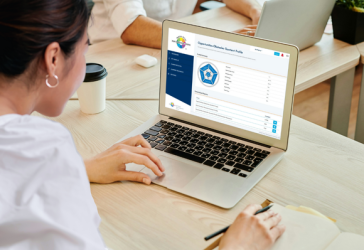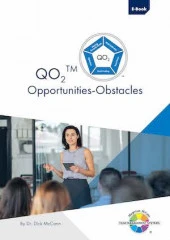Leaders make things happen that wouldn’t happen by themselves. They are catalysts for change. The Opportunities-Obstacles Quotient (QO2) Profile measures how an individual is likely to lead and approach change, based on their tolerance for risk.
The QO2 Profile can significantly enhance team dynamics by focusing on several key aspects of team behaviour and interaction.
The QO2 Profile reveals how individuals and teams respond to uncertainty, drive towards goals, tackle challenges and maintain momentum - especially when outcomes aren’t guaranteed.
Grounded in research, the QO2 Profile identifies why some people:
- Are threatened by change and others energised by it
- Only focus on the future or won’t let go of the past
- Can see many solutions to a problem and others only one
- Assume the best and others assume the worst
- Are goal oriented and others aren’t
The QO2 is widely used across industries for leadership development, team effectiveness, strategy implementation and change programs. It is especially valuable when clarity, adaptability and psychological pacing are critical.
The QO2 is a powerful tool in helping members understand others approach to risk taking and openness to new ideas. When selecting climbing partners, QO2 really comes to the fore especially when making a summit bit for Everest.
Bob Killip & Zac Zaharias, Everest Expedition
What the QO2 measures

The QO2 is built around five core subscales of risk orientation:
- Moving Towards Goals Energy - the drive and resilience individuals apply toward achieving goals and seizing opportunities.
- Multi-Pathways - the ability to consider and pursue multiple options and alternative strategies for achieving desired outcomes.
- Optimism - the extent to which individuals maintain a positive outlook, especially when facing challenges or uncertainty.
- Fault-Finding - the tendency to focus on potential problems, errors, or risks when evaluating ideas or actions.
- Time Focus - whether individuals are more oriented toward the past, present, or future in their decision-making and risk evaluation.
It also reports two key indices:
- Handling Change - how positively and proactively an individual responds to change, challenge, and uncertainty.
- Resilience - a person’s capacity to recover from setbacks, maintain optimism, and sustain goal-directed effort over time.
Together, these dimensions paint a clear picture of how individuals and teams perceive obstacles, act on opportunities and sustain performance during change.
Using QO2 with Team Signals

Team Signals is a multi-rater engagement diagnostic and pulse-check tool that helps teams understand how they’re functioning right now, and where to focus next. It captures both leader and team perspectives, turning real-time feedback into clear development priorities.
When used alongside the QO2 Profile, Team Signals provides a broader view of team dynamics. It highlights what’s helping or hindering engagement and where development efforts will have the greatest impact.
This combination is especially effective:
- At the start of a change program, to surface early risks and engagement needs.
- During mid-project reviews, to check whether the team’s energy and alignment are holding.
- In leadership transitions, to give new leaders a clear read on team engagement and risk readiness.
- To orient teams in their cycle of change, and guide next steps in developments
Together, QO2 and Team Signals help teams move forward with clarity, resilience and purpose, linking engagement insights with targeted action.
Get Started with QO2

To access the QO2 you can enlist the services of one of our associates who are accredited in the profile, or you can become accredited to deliver a QO2 debrief yourself.
Through an Accredited Practitioner gain access to TMS Global, our product delivery platform
- Answer the QO2 Questionnaire
- Read your QO2 report
- Attend a debrief with your Accredited Practitioner
Our other profiles
Team Management Profile (TMP)
Building Capable Teams: COLLABORATE
The Team Management Profile (TMP) is a science-based feedback tool designed for personal, team, and leadership development. It integrates work-focused feedback to help individuals understand their work styles and improve collaboration. Underpinned by models that combine work and people contexts, TMP offers a holistic view of work preferences, enhancing performance at individual, team, and organisational levels. By promoting understanding and leveraging personal insights, TMP fosters effective teamwork and high-performance environments.
Window on Work Values (WoWV) Profile
Building Capable Teams: ALIGN
The Window on Work Values (WoWV) Profile is a comprehensive tool designed to enhance individual and team performance by aligning personal work values with organisational objectives. Measuring eight core value types—Individualism, Collectivism, Authority, Equality, Compliance, Empowerment, Independence, and Conformity—it provides detailed insights into individual motivations and behaviours. This understanding aids in identifying value alignment, addressing misalignment, and fostering team development through a customised Team Values Statement and Team Charter.
Linking Leader Profile (LLP|360)
Building Capable Leaders: LEAD
The Team Management Systems (TMS) view on leadership emphasises the importance of relationships. The Linking Leader Model identifies 13 essential Linking Skills across three levels: People Linking, Task Linking, and Leadership Linking. These skills are crucial for effective teamwork and leadership, ensuring sustainable high performance. The LLP|360 tool measures these skills and integrates them with established leadership theories, such as Transformational and Situational Leadership, to enhance leadership development programs.


